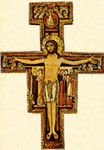Breathing with Both Lungs -- East & West -- among Arab Catholics
 Today we Catholics celebrate the memorial of St. Sharbel (or, Charbel) Makhlouf, a Lebanese monk, hermit and priest from the 19th century (1828-1898). His reputation for sanctity preceeded his death and he apparently was widely respected by Christians and non-Christians in his native land.
Today we Catholics celebrate the memorial of St. Sharbel (or, Charbel) Makhlouf, a Lebanese monk, hermit and priest from the 19th century (1828-1898). His reputation for sanctity preceeded his death and he apparently was widely respected by Christians and non-Christians in his native land.
Pope John Paul II wrote back in the 1990s, Lumen Orientalis (Light from the East), that the Catholic Church "breathes with two lungs, East and West." Probably for most Catholics in the USA this is a pretty foreign concept. Perhaps some Catholics, young and old, have a kind of abstract notion of this. They may know that it exists, but it's pretty exotic and not part of their daily lives, or even their general awareness as practicing Catholics.
St. Sharbel was from the Aramaic Maronite Syriac Catholic Church, oftentimes abbreviated as the Maronite Rite. It is from the Syriac liturgical family which traces its roots to the earliest Christian communities in what is now Israel, Lebanon, Syria and Palestine. They have a patriarch, Cardinal Sfeir, who is the rightful successor (among others) to St. Peter of the Church of God which is in Antioch (Syria). Today, sadly, it is only a historical site of Roman ruins in a wee corner of southern modern Turkey. The patriarch has his see in Beirut, the capital of Lebanon. And he has been an outspoken advocate for peace in the region, the common respect of human rights for all the inhabitants in the region, especially for Christians, who comprise about one-third of the population of Lebanon.
Patriarch Nasrallah Peter Cardinal Sfeir, Maronite Patriarch of Antioch, headquarters in Beirut, Lebanon, serving since 1986
But to label these folks as "Arabs" is not entirely just. They are also Phoenecians, descendants of some of the oldest known inhabitants of the Lebanese coastland (predating Greek civilization). Their form of the Syriac Rite is attributed to St. Maron (hence, the name), a 5th century bishop in what is now Lebanon, and they have been in continual communion with the Church of Rome these many centuries.
One challenging thing I have found is that when I mention that there are thousands of Arab Christians, even millions in Arab lands (e.g. Egypt) -- Orthodox, Catholics and even Protestants -- people seem to be stunned. I remember one person commenting, "I had no idea there were Muslim Christians!" I tried to explain (I think I was successful!) that these were not Muslims; they were Christians, and they were Arabs (or, living in Muslim lands, having inhabited the lands predating not only Muhammed and the subsequent Arab invasion, but even the Christian era).
Christian Syriac script of Bible text from the Book of Exodus
 So, our Catholic Christian heritage is truly rich, thanks be to God, with such a plurality of practice and profound diversity of ritual, language and customs, even from ancient times of the early Church!
So, our Catholic Christian heritage is truly rich, thanks be to God, with such a plurality of practice and profound diversity of ritual, language and customs, even from ancient times of the early Church!We do breathe with two lungs, East and West. Here in the USA, I encourage our young people, especially in the Roman Rite (and the vast majority of Catholics belong to this Rite in our country) to become familiar with the Eastern Churches, especially if there are some in your area.
The Eastern Catholic Churches (i.e. in communion with the Pope of Rome, as opposed to the Eastern and Oriental Orthodox, who are not) are quite diverse -- Byzantine (Ruthenian, Melkite, Romanian, Ukrainian, Russian, Bylorussian) and Syriac (Maronite, Syriac, Chaldean, Syro-Malankara, Syro-Malabar), Armenian, Alexandrian (Coptic, Ethiopic) -- and you can receive Holy Communion (according to their respective tradtions) in these Churches, too!


2 comments:
Whoever owns this blog, I would like to say that he has a great idea of choosing a topic.
Pace e bene, frati! I had just set up my blog 'Breathin with both lungs' when i decided to search and check if it showed up on the net but I found you instead! Blessings o n your work.
Post a Comment